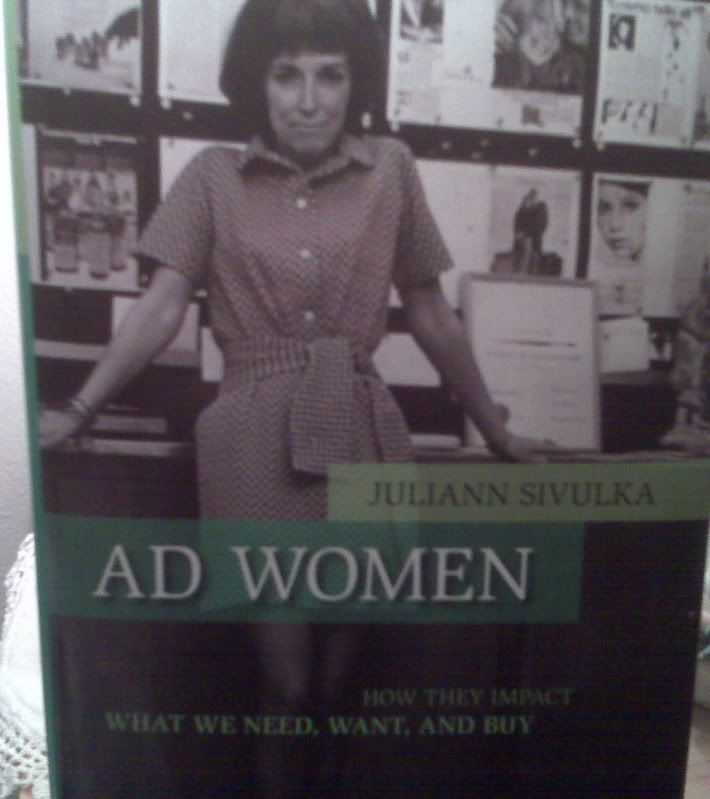Women, Advertising, and Today’s Gender Questions
 I just completed an absolutely incredible book called Ad Women: How They Impact What We Need, Want, and Buy, by Juliann Sivulka. It is one of the most incredible studies of gender history in the US I have encountered (and I’ve read a lot of history books!).
I just completed an absolutely incredible book called Ad Women: How They Impact What We Need, Want, and Buy, by Juliann Sivulka. It is one of the most incredible studies of gender history in the US I have encountered (and I’ve read a lot of history books!).
Beginning in 1869 and taking her study into 2007 or so, Sivulka somehow manages to tie together the history of advertising, consumer history, race history, and world history, all while bringing it back to women who have worked in advertising over the years.
Given that, it’s impossible to explain in a single blog post everything you can learn from reading this book, but let me throw a few thoughts your way.
Women know what they’re supposed to know
Beginning in the late nineteenth century and moving to modern ads that portray husbands as inept goofballs, women have always known what their areas of expertise are supposed to be. In the nineteenth century, really all the way through the 1970s, women were supposed to know everything about the domestic arts. This covered everything from house decor to fashion for the husband and kids.
There have been a couple of times over the long years when this has gotten a bit blurry as lines go. For example, when new washers and dryers came out, marketers thought that men should be targeted because these were “machines.” However, laundry was considered to reside so entirely in the woman’s domain that women actually found themselves coaching men how to use these complex gadgets. That caused quite a few ripples.
Fast forward to now. You have probably noticed that there are a LOT of ads where men are portrayed as downright stupid when it comes to household chores. You might say that this is a sexist representation of men, and you’d probably be right. But there’s also an underlying current there – women still dominate when it comes to care of the home. Compared to a woman, a man is hopeless. Not very modern, right?
Behind every man is a strong woman
Another interesting thing this book covers is the phenomenon of why so many women find themselves in subordinate positions even if they are really more skilled than the men. Over and over again, Sivulka tells the tale of women who ran huge agencies, and it was no secret, but the woman did not show herself in the office, did not dispute the fact that her husband (or whomever) was the president, and in fact agreed with segregating the sexes in the office building.
If a woman did find herself to be entirely successful, she was left with the debate that continues to plague women to this day. “Do I keep doing this, or do I give everything up to be a wife and a mom?” Until about the 1970s and then into the 80s, this was the only choice for women. And a lot of women whom Sivulka profiles didn’t have a problem or qualms with this aspect of their careers. A woman would give up everything to be there for her kids, and then in the 1970s, the Supermom was expected to remain successful at work while also maintaining that aspect of motherhood that she had been used to as a child.
Do women today, successful women, still find themselves wondering if they should dedicate themselves more to their home and their kids? I would wager yes.
Did a lot of men run with this sacrificial aspect of women? Absolutely. Some of the most successful women in marketing were banned from all-men’s advertising groups, banned from special first class commuter trains, and more.
“The Woman” is our target
Another major topic that Sivulka covers throughout the book is the fact that marketers latched on to the idea that they could target white, middle class women. In the early days, she was the one making decisions about what to buy. In the 1950s, she was going out to stores herself to do the shopping. For decades upon decades, marketers targeted this one group of women. Men and women in advertising shaped their campaigns around what they thought “this woman” would want. There was no attention to racial minorities, of course. The emphasis, ultimately, was on how “this woman” could be attractive to men, then a good wife, and finally a good mother. Women over 49 need not exist, thank you.
Now, of course, you can’t miss the fact that there is not just “this woman.” That makes the job of marketers all the harder – and as Sivulka points out, instead of targeting people by their jobs, their economic class, or their genders, marketers have to target people by their ideologies. How do you sell a product to a woman who believes you should stay at home while also tempting the woman who believes that staying at home is old fashioned? Because that is the spectrum that is out there.
Somebody stop me
I could go on and on – this was a very enlightening book, and interesting on so many levels, from learning how advertising became equated with evil to all of the things I mention above.
Check it out and let me know what you think – and in the meantime, let me know your thoughts about some of the questions Sivulka poses!
